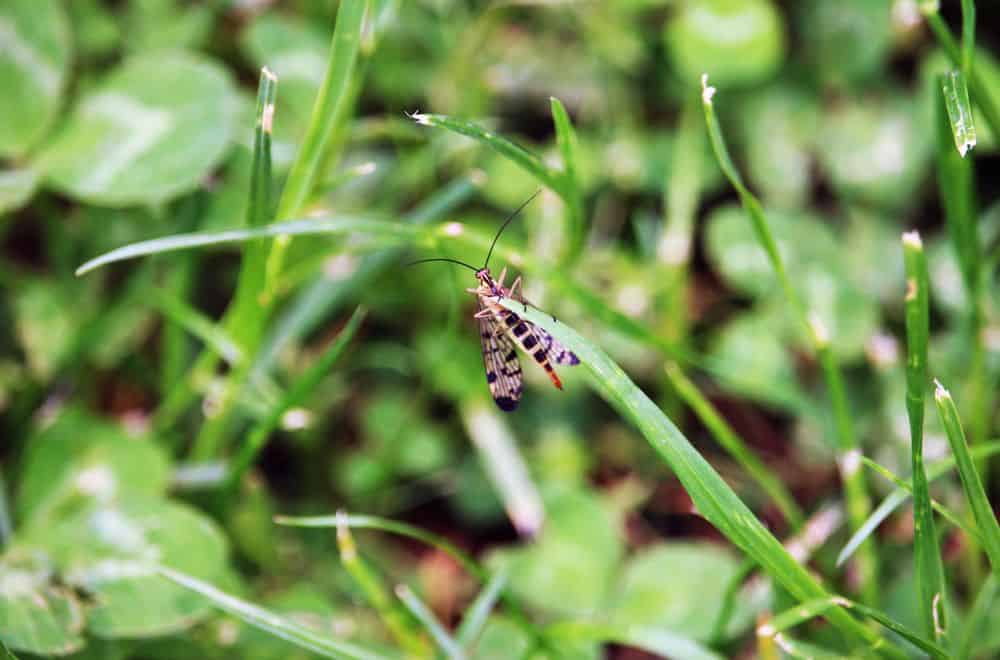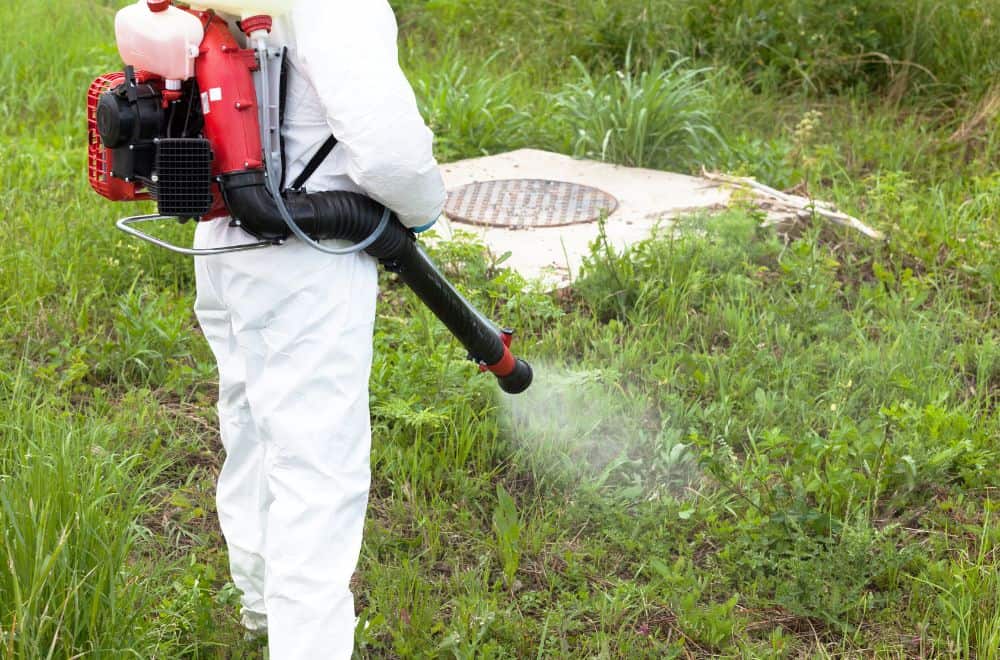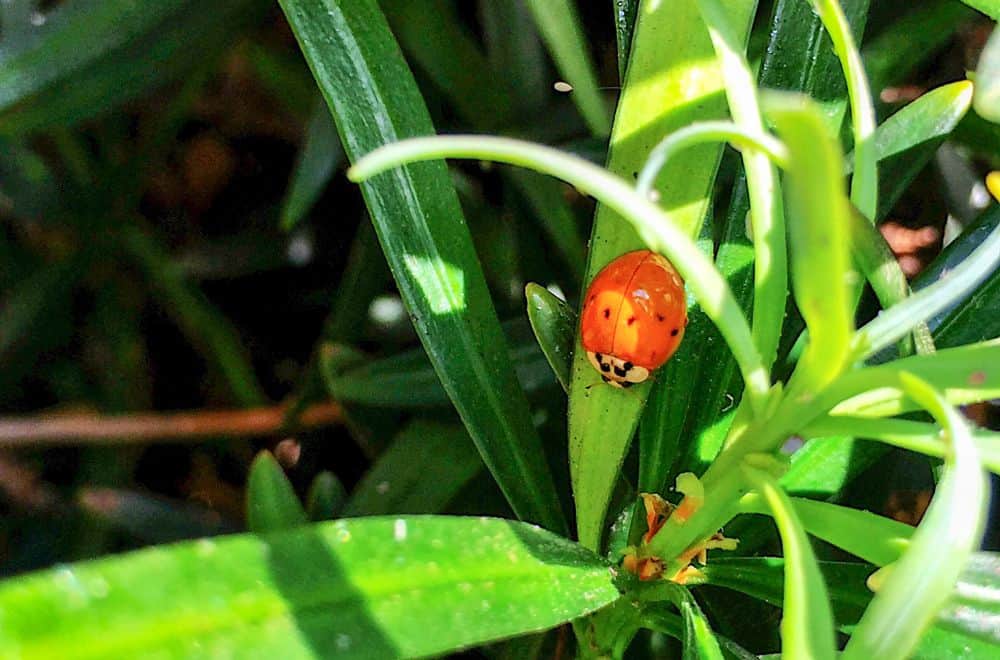I agree that there are a lot of harmful insects that can damage your lawn, but that doesn’t mean that you should kill every bug you see around your grass, flowers, and trees.
Too often, you may kill beneficial insects while trying to destroy harmful ones. That way, you will harm your yard more severe than if you didn’t take any action. Sometimes it’s really better to let nature solve these problems.
The Most Common Flying Bugs in Your Lawn

Here, I will talk about flying bugs you can spot in your lawn. The most often, you will have problems with tiny, mosquito-like Lawn gnats that hover over grass in huge swarms.
These annoying 0.125 inches (0.3 cm) long pests prefer hot and rainy weather, and you can expect them to develop in the damp soil rich in decaying plant material or around your composter.
Even though you will probably hate these flying menaces, they are actually entirely harmless. You should pay attention to their larvae which will destroy the fine hairs of your plant’s roots. As a result, you can see yellow and withered leaves while the plant itself loses vigor.
Except for Lawn gnats, there are other insects which can invade and consequently destroy your lawn over time. Most of them, including Frit Fly, feed near the grass’ roots. And, you can already guess – their larvae bore through the stems of grass and cause patchy areas on leaves.
The list of insects on/in your lawn
| The name of insects | |
| Ants | They won’t damage your grass, but they make the tunnels into the soil which cause problems |
| Aphids | They feed on grass and make it weak |
| Armyworms | They feed on turf grasses and destroy them by chewing leaves down to the ground |
| Billbugs | They burrow in the stems and damage lawns, especially Zoysia grass |
| Chiggers | They invade lawns and can cause skin irritation and itching |
| Chinch bugs | They usually damage St. Augustine grass, but can be harmful to Zoysia, Centipede, and Bermuda as well |
| Cutworms | They can ruin seedlings of Bentgrass, Bermudagrass, and ryegrass by feeding on the leaves |
| Earthworms | They become pests when getting too overwhelmed |
| Earwigs | You can spot them in your lawn occasionally, usually in piles of lawn clippings |
| Fire Ants | You can face enormous fire ant mounds which will probably destroy your lawn |
| Fleas | They are harmless for the lawn, but when widespread throughout it, they can infest your pets and make troubles to you and your kids |
| Grasshoppers | They avoid well-kept lawns and usually migrate to them from nearby wastelands and croplands |
| Grubs | They live underground and feed on the tender grass’ roots until killing the whole plant |
| Japanese Beetles | Their grubs feed on the grassroots and adult destroy plant leaves |
| Leafhoppers | They suck the sap from your grasses’ leaves until destroying the whole lawn |
| Millipedes and Centipedes | They usually don’t damage lawns since they consume chiefly decaying vegetable matter |
| Mites | Only a few species attack grasses by sucking their sap |
| Mole Crickets | They feed on grass, other organic material, and insects and there is no way to eradicate them |
| Slugs and Snails | By moving on your lawn, they often damage adjacent plants |
| Spiders | Except for black widow and brown recluse spiders, they don’t damage the grass |
| Spittlebugs | They usually won’t harm a well-managed lawn since they feed on weeds |
| Sod Webworm
/ Webworm moth |
Their caterpillars will chew off the blades of your grass and destroy them |
| Thrips | They won’t harm your lawn, but they may inflict painful bites to you |
| Ticks | They are harmless to your lawn but may transmit several diseases, including Lyme Disease or Human Monocytic Ehrlichiosis |
How to Prevent and Stop Flying Bugs in Your Lawn

The excellent way to prevent these bugs from making severe damage is to get rid of them. One of the most comfortable and effective ways is appropriate watering and emptying the rain barrel you keep in your yard regularly.
Don’t overwater your lawn and thus you will avoid creating a favorable environment for the development of these harmful insects. When you let your soil to dry out between two watering, it will be less attractive to bugs.
Physical Controls
- Sand – Since adults lay eggs in the top 0.25 inches (0.6 cm) of moist soil, you should sprinkle 0.5 inches (1.3 cm) of sand over the surface of the ground. This is an effective way to control larvae.
- Potato slices – It is a quick way to control bugs’ larvae. Just slice raw potatoes into 1 x 1 x 0.25 inches (2.5 x 2.5 x 0.6 cm) pieces and place the slices on the potting media surface. After approximately four hours, move the potato with larvae. Repeat the procedure as many times as necessary.
- Vinegar or beer – Controlling adults is the whole different story. Fill a jar or jug to half with beer or apple cider vinegar and add a couple of drops of dish soap. Put the lids on, make a few larger holes on it and wait for bugs to enter.
- Sticky traps – Make a sticky trap of Vaseline smeared on a few 4 x 6 inches (10 x 15 cm) pieces of yellow cardstock. Place them above the potting media surface and put adult bugs under control.
- Flypaper ribbons – Hung these ribbons everywhere possible to catch outdoor flies. Pay attention to put them high enough to avoid sticking your hair, furniture, or plants.
- Cover drainage holes – To let water pass through the drainage holes freely, but to prevent bugs from laying eggs there at the same time, you need to cover these holes with a piece of synthetic fabric and attach them by using rubber bands.
- Diatomaceous earth – This mineralized fossil dust is highly effective against larvae. Basically, microscopic pieces of silica this earth consist will physically destroy the insect’s larvae while passes through them.
Biological control
- Cultural control – Eliminate damp vegetation, dry the ponds, and allow the soil surface to dry between watering.
- Bacteria – Use Bacillus thuringiensis subspecies israelensis (Bti) to get rid of larvae of flying insects in your lawn. These bacteria disrupt the digestive tract of larvae and cause their death by starvation. The advantage of this method is that Bti is harmless for people and pets.
- Predaceous nematodes – An excellent way to kill flying insects is to spray the solution of nematodes Steinernema feltiae and water throughout your lawn. Repeat the procedure every few weeks early in the morning until solving the problem.
Chemical control
- Insecticides – You need to use a liquid insecticide effective against flying insects. Pick out a day without rain and wind to spray the surface of your lawn with the chosen product. Check grass after four days and repeat the application if necessary.
Before you decide to solve the problem with flying bugs in your lawn by using chemicals, be sure that you read carefully and entirely understand user manual. Most insecticides are harmful to other creatures too. I am sure that you don’t want to hurt your pets and other wildlife while killing insects.
Not to mention that these chemicals can also harm your children. Be careful and do the best thing for both your lawn and all living beings around.

Leave a comment